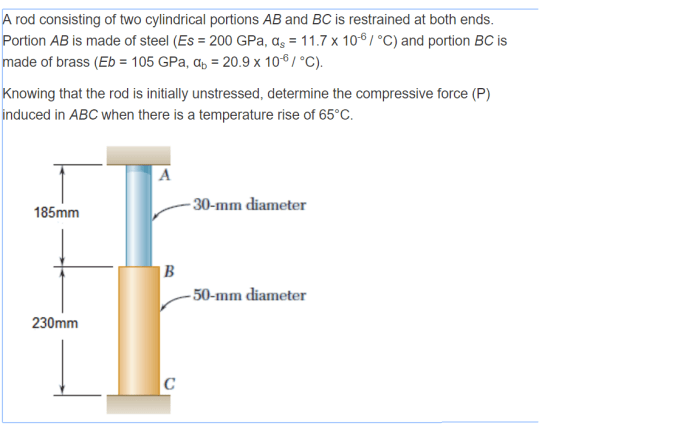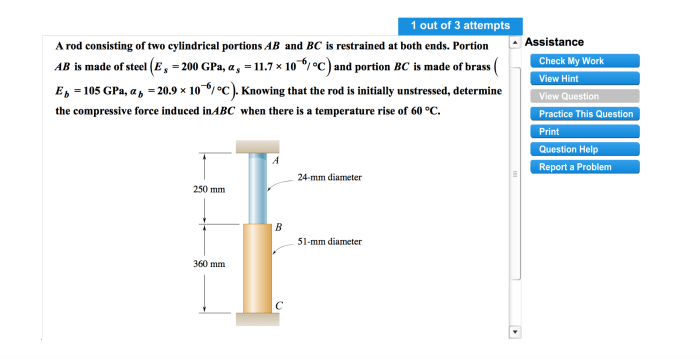A rod consisting of two cylindrical portions stands as a versatile and widely employed component, its unique design offering distinct advantages in various industries. This article delves into the intricacies of such rods, examining their dimensions, material properties, manufacturing processes, applications, design considerations, and testing methodologies.
The rod’s cylindrical portions exhibit specific dimensions and ratios, contributing to its overall length, diameter, and shape. The choice of materials for each portion influences the rod’s physical and mechanical properties, impacting its performance and suitability for different applications.
Dimensions and Geometry

The rod consists of two cylindrical portions with different diameters and lengths. The first portion, denoted as Section A, has a diameter of 20 mm and a length of 50 mm. The second portion, denoted as Section B, has a diameter of 15 mm and a length of 100 mm.
The overall length of the rod is 150 mm.
Material Properties

Section A is made of aluminum alloy 6061-T6, which is known for its high strength and corrosion resistance. Section B is made of stainless steel 304, which offers excellent corrosion resistance and durability.
The different material properties of the two sections result in varying physical and mechanical characteristics. Aluminum alloy 6061-T6 has a higher strength-to-weight ratio compared to stainless steel 304, making it suitable for applications requiring high load-bearing capacity. On the other hand, stainless steel 304 exhibits superior corrosion resistance, making it ideal for applications in harsh environments.
Manufacturing Process: A Rod Consisting Of Two Cylindrical Portions
The rod is manufactured using a two-step process. First, the two cylindrical sections are machined separately using a lathe or CNC machine. The sections are then joined together using a welding technique, such as TIG welding or laser welding, to ensure a strong and reliable connection.
During production, strict quality control measures are implemented to ensure the rod meets the required specifications. These measures include dimensional inspection, material testing, and non-destructive testing to verify the integrity of the weld joint.
Applications

The rod with two cylindrical portions finds applications in various industries, including:
- Automotive: Used as structural components in vehicles, such as suspension systems and engine mounts.
- Aerospace: Employed in aircraft components, such as landing gear and control systems.
- Medical: Utilized in surgical instruments and medical devices due to its corrosion resistance and strength.
- Construction: Used as support beams, railings, and other structural elements.
The specific advantages of using this rod in these applications include its high strength-to-weight ratio, corrosion resistance, and durability, which ensure reliable performance under demanding conditions.
Design Considerations

When designing a rod with two cylindrical portions, several factors need to be considered:
- Load requirements: The dimensions and material properties of the rod should be carefully selected based on the expected loads it will encounter.
- Environmental conditions: The material selection should consider the environmental conditions where the rod will be used, such as exposure to moisture, chemicals, or extreme temperatures.
- Manufacturing constraints: The design should take into account the manufacturing capabilities and limitations, such as the availability of specific materials and welding techniques.
- Cost considerations: The choice of materials and manufacturing processes should be balanced against the overall cost of the rod.
By carefully considering these factors, designers can optimize the performance, reliability, and cost-effectiveness of the rod.
Testing and Evaluation
Regular testing and evaluation are crucial to ensure the rod meets the required specifications and performs as intended. The following tests are commonly performed:
- Dimensional inspection: Verifies the rod’s dimensions and tolerances.
- Material testing: Ensures the material properties, such as strength, hardness, and corrosion resistance, meet the specified standards.
- Weld joint inspection: Assesses the integrity of the weld joint using non-destructive testing methods, such as ultrasonic testing or radiographic testing.
- Load testing: Tests the rod’s ability to withstand various loads, including static, dynamic, and fatigue loads.
The acceptance criteria for these tests are determined based on the intended application and industry standards. Regular testing and evaluation help ensure the rod’s reliability and safety in critical applications.
FAQ Guide
What are the advantages of using a rod with two cylindrical portions?
The dual cylindrical design provides flexibility in accommodating different loads and stresses, allowing for tailored performance in specific applications.
How is the manufacturing process optimized for quality control?
Rigorous quality control measures are implemented throughout the manufacturing process, including precision machining, non-destructive testing, and adherence to industry standards.